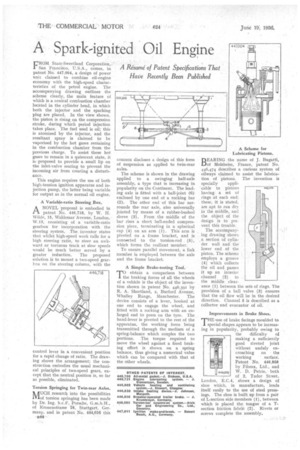A $park-ignited Oil Engine F OM Starr-Sweetland Corporation,. San Francisco, U.S.A.,
Page 54

If you've noticed an error in this article please click here to report it so we can fix it.
comes, in patent No 447,004, a design of power unit claimed to combine oil-engine economy with the high-speed characteristics of the petrol engine. The accompanying drawing outlines the scheme clearly, the main feature of which is a conical combustion chamber located in the cylinder head, in which both the injector and the sparking plug are placed. In the view, shown, the piston is rising on the compression stroke, during which period injection takes place. The fuel used is oil; this is atomized by the injector, and the resultant spray is claimed to be vaporized by the hot gases reniaixting in the combustion chamber from the previous charge. To assist these hot gases to remain in a quiescent state, it is proposed to provide a small lip on the inlet-valve seating to prevent the incoming air from creating a disturbance.
This engine requires the use of both high-tension ignition apparatus and injection pump, the latter being variable for output as in the normal oil engine.
A Variable-ratio Steering Box.
ik NOVEL proposal is embodied in 1-1. patent No. 446,718, by W. H. Wilde, 15, Waldemar Avenue, London, W.13, consisting of a variable-ratio gearbox for incorporation with the steering system. The, inventor states that whilst high-speed work Calls for a high steering ratio, to steer an awkward or tortuous track at slow speeds would be much better served by a greater 'reduction. The proposed solution is to mount a two-speed gearbox on the steering column, with the
control lever in a convenient position for a rapid change of ratio. The drawing shows the arrangement; the construction embodies the usual mechanical principles of two-speed gears, except that the neutral position is, so far as possible, eliminated.
Torsion Springing for Twin-rear Axles.
ft/NCH research into the possibilities liflof torsion springing has been made by Dr. Jug. b.c.F. Porsche, G.m.b.H., of Kronenstrasse 24, Stuttgart, Germany, and in patent No. 444,616 this s44 concern discloses a design of this form of suspension as applied to twin-rear axles.
The scheme is shown in the drawing applied to a swinging half-axle assembly, a type that is increasing in popularity on the Continent. The leading axle is fitted with a ball-joint (6) enclosed by one end of a rocking bar (2). The other end of this bar surrounds the rear axle, also universally jointed by means of a rubber-bushed sleeve (3). From the middle of the bar rises a short ball-ended compression piece, terminating in a spherical cap (4) on an arm (1). This arm is pivoted on a frame bracket, and is connected to the torsion-rod (5), which forms the resilient member.
To ensure parallel movement, a link member is employed between the axle and the frame bracket.
A Simple Brake-testing Tool. obtain a comparison between the braking forces of all the wheels of a vehicle is the object of the invention shown in patent No. 446,391 by R. A. Shortland, 2, Burford Avenue, Whalley Range, Manchester. The device consists of a lever, hooked at one end to engage the wheel, and fitted with a rocking arm with an enlarged end to press on the tyre. The hand-lever is pivoted to the rest of the apparatus, the working force being transmitted through the medium of a spring-balance which couples the two portions. The torque required to move the wheel against a fixed braking effort is shown on a spring balance, thus giving a numerical value which can be compared with that of the other wheels.
A Scheme for Lubricating Pistons..
BEARING the name of J. Bugatti, of Molsheim, France, patent No. 446,474 describes a curious system of oitways claimed to assist the lubrication of pistons. The invention is specially applicable to pistons having a set of rings at each end; these, it is stated, are apt to run dry in the middle, and the object of the design is to prevent this trouble.
The accompanying drawing shows a section of cylinder wall and the lower end of the piston. The schema employs a groove (4) which collects the oil and passes it up an interior channel (2) to the middle clearance (1). between the sets of rings. The provision of a ball valve (3) ensures that the oil flow will be in the desired direction. Channel 5 is described as a collector and evacuator of oil.
Improvements in Brake Shoes.
THE-use of brake facings moulded to special shapes appears to be increasing in popularity, probably owing to
the difficulty of making a sufficiently good riveted joint without unduly encroaching on the working surface. Patent No. 446,858 by Fibrax, Ltd., and W. D. Petrie, both of 2, Tudor Street. London, E.C.4, shows a design of shoe which, in manufacture, lends itself easily to the use of steel pressings. The shoe is built up from a pair of L-section side members (1), between which is placed the tongue of a Tsection friction fabric (2). Rivets or screws complete the assembly.




















































































